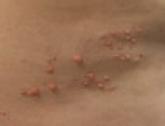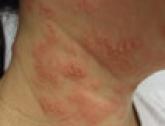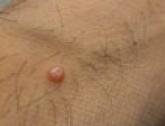Article

Incidental (Malignancy) and Coincidental (Idiopathic Polydactylous Longitudinal Erythronychia) Conditions in Patients With Segmental Neurofibromatosis
- Author:
- Cohen PR
Segmental neurofibromatosis (SNF) is an uncommon presentation of neurofibromatosis type 1 (NF-1).
Article

Ramsay Hunt Syndrome Revisited
- Author:
- Chodkiewicz HM
- Cohen PR
- Robinson FW
- Rae ML
Varicella-zoster infections commonly are seen in clinical practice; however, Ramsay Hunt syndrome caused by reactivation of latent varicella-...
Article

Plantar Molluscum Contagiosum: A Case Report of Molluscum Contagiosum Occurring on the Sole of the Foot and a Review of the World Literature
- Author:
- Cohen PR
- Tschen JA
Molluscum contagiosum (MC) is a skin infection caused by the double-stranded DNA virus of the family Poxviridae that typically presents as flesh-...
Article
Omphalith-Associated Relapsing Umbilical Cellulitis: Recurrent Omphalitis Secondary to a Hair-Containing Belly Button Bezoar
- Author:
- Cohen PR
- Robinson FW
- Gray JM
We report an 18-year-old man with recurrent cellulitis of his umbilicus and surrounding skin. Thorough investigation revealed a foreign body as...
Article
Harpist's Finger: Case Report of a Trauma-Induced Blister in a Beginner Harpist and Review of String Instrument–Associated Skin Problems in Musicians
- Author:
- Cohen PR
Musicians may develop skin problems resulting from playing their instruments.
Article
Successful Treatment of Auricular Pseudocyst Using a Surgical Bolster [letter]
- Author:
- Cohen PR
No abstract available.
Article
Community-Acquired Methicillin-Resistant Staphylococcus Aureus Skin Infection Presenting as a Periumbilical Folliculitis
- Author:
- Cohen PR
Community-acquired methicillin-resistant Staphylococcus aureus (CAMRSA) infection is a clinical problem of increasing global incidence. CAMRSA...
Article
Familial Median Canaliform Nail Dystrophy
- Author:
- Sweeney SA
- Cohen PR
- Schulze KE
Median canaliform nail dystrophy typically appears as a central nail groove, beginning at or distal to the proximal nail fold, from which small...
Article
Darier Disease: Sustained Improvement Following Reduction Mammaplasty
- Author:
- Cohen PR
Darier disease is an autosomal-dominant inherited genodermatosis. A woman is described who had Darier disease and hereditary spherocytosis whose...
Article
Subacute Cutaneous Lupus Erythematosus: Report of a Patient Who Subsequently Developed a Meningioma and Whose Skin Lesions Were Treated With Isotretinoin
- Author:
- Richardson TT
- Cohen PR
Cancer has been reported in patients with systemic lupus erythematosus (SLE). A possible association of the development of hematologic...
